I tried playing the world-famous board game 'Catan 3D Edition', which can be played luxuriously with fully painted 3D tiles and pieces

A deluxe version of the popular board game '
Catan 3D version
http://www.gp-inc.jp/boardgame_catan_3d.html
The packaging for the 3D version of Catan looks like this. Its dimensions are 465mm wide x 335mm high x 130mm deep.

Here it is being held by an editorial staff member who is 151cm tall.

The actual weight was 3.65kg.

The rules are the same as the regular Catan. The target age is 10 years old and over, the number of players is 3 to 4, and the play time is 60 minutes.

This is what it looks like when you open the box.

The inner box has a lid, so when storing it normally you can just close the lid without having to put it back into the presentation box.

The 3D terrain tiles look like this: the top row is forests, fields, and pastures, and the bottom row is mountains, hills, and deserts.

It was very detailed and all painted. There was a flock of sheep in the pasture.

The field is about half-cut, and you can see bales of straw lying around.

Rugged, towering mountains and gentle hills.

The back of the 3D terrain tile had the Catan logo engraved on it. The three-dimensional design was based on a hand-carved sculpture by Klaus Teuber, the creator of Catan.

When viewed from the side, you can clearly see the three-dimensional effect.

An ocean frame surrounds the 3D terrain tile.
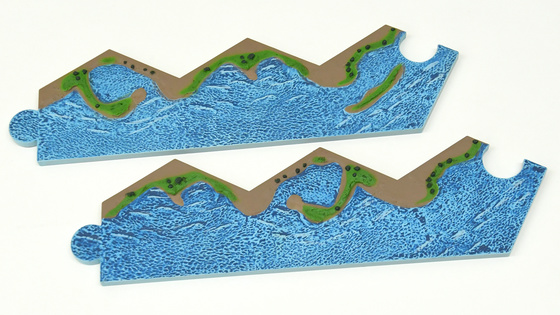
The port is an inlet, with trees growing along the shore and small islands floating on it. The sea is also unevenly carved, and is painted in blue and white to represent the waves.
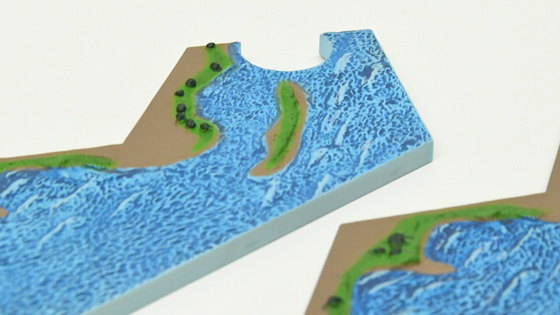
And then there are ship pieces that represent the ports where you can exchange resources. The top row is for specialized ports where you can exchange specific resources at a 2:1 rate, and the bottom row is for general ports where you can exchange any resource at a 3:1 rate.

If you look at the Specialty Port piece, you can see that there are two sheep, two iron, two wheat, and two other resources on the ship.

There were three wooden boxes on the general port piece.

The pieces used by players are four colors: white, red, blue, and yellow.

From the left, the frames show the highway, the settlement, and the city. The stone paving patterns, roofs, window frames, and other extremely fine details are faithfully reproduced in 3D. The images have already been
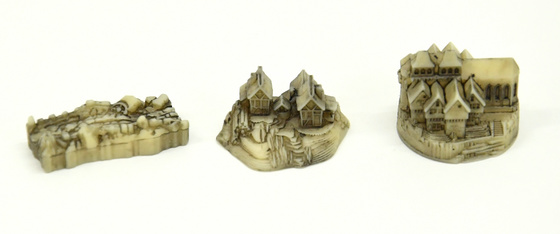
And here's what the thief pieces that move around on the board during play look like. There are three of them, and the shortest thief is holding an animal that looks like a sheep.

The dice used to play are red and yellow. If you look closely, the dice are hexagonal, just like the tiles of Catan, and the number 1 has the word 'CATAN' engraved on it.

The number tokens look like this, made of plastic. The numbers on them correspond to the sum of the dice rolls, and the number of dots underneath represents the probability of the number. For example, the most likely numbers to appear, 6 and 8, have five dots on them, while the least likely number, 2, has only one dot.
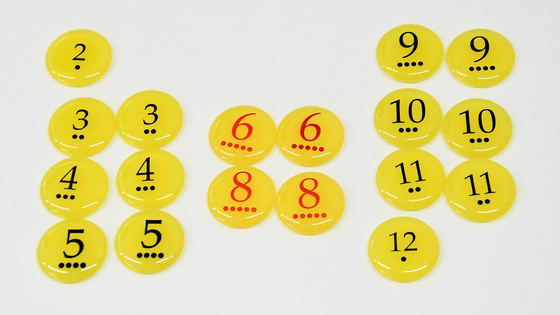
The numerical tokens are shaped like marbles and are so shiny that they reflect their surroundings, giving them a somewhat luxurious feel.
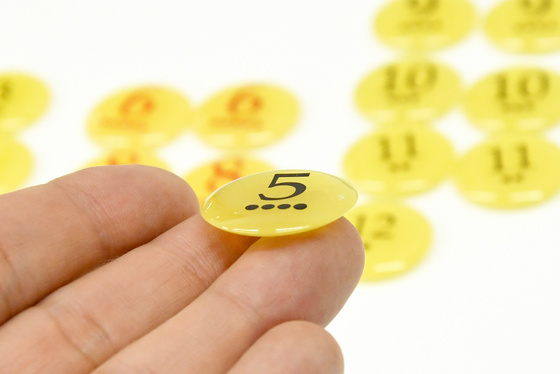
And then there are the cards you use during the game. There are two types: resource cards and development cards.
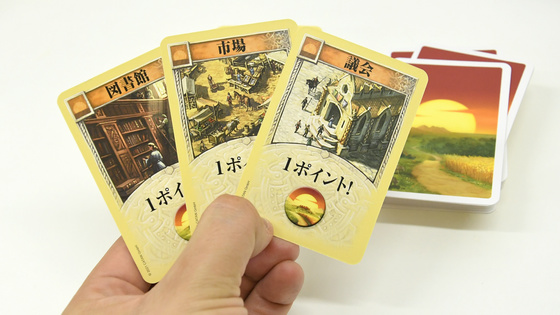
There are two plastic card trays, which you can place cards into as shown below.
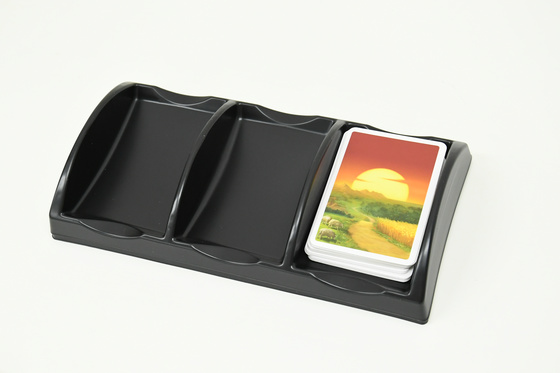
Also included is a cardboard construction cost chart, a 'Maximum Knight Strength' card, and a 'Longest Trade Route' card.
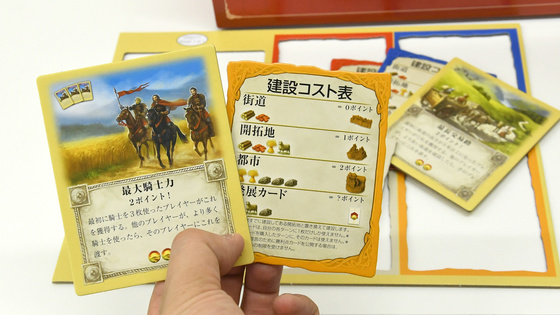
Let's play with four people right away. Normally, you place terrain tiles and initial settlements and roads, but this time, the 'most balanced' initial placement was listed in the instructions, so we arranged them according to that.
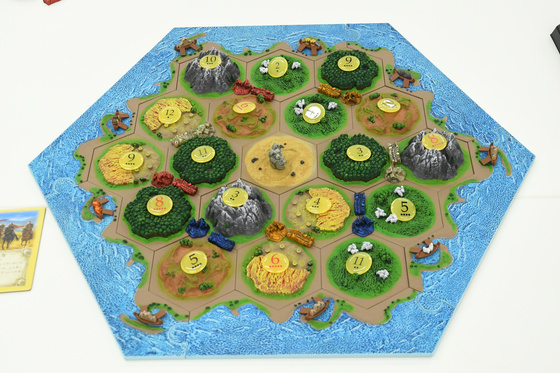
Place the five resource cards and the development cards on a card tray next to the board. The card tray with the deck is called the 'bank' in the game.
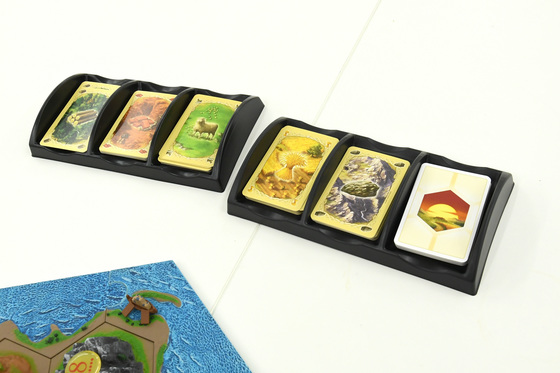
Place the Longest Trade Route card and the Maximum Knighthood card next to the board.
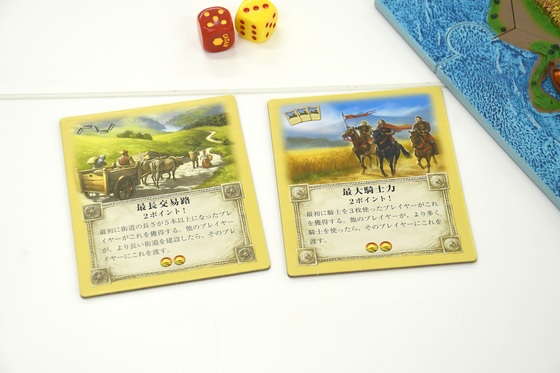
Then hand out road, settlement, and city pieces and a construction cost table to each player and you're ready to go.
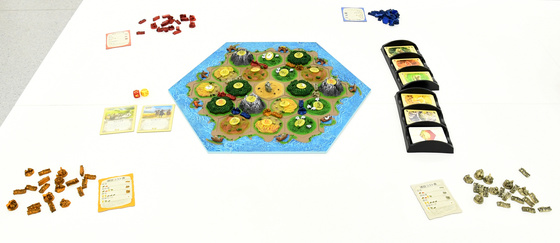
The way to play the game is very simple, just like the traditional Catan . Players roll two dice on their turn, build with the resources they get, and expand their town. The player who reaches 10 victory points at the end wins.
I rolled the dice and got a 3 and a 3, so the total came up was 6.
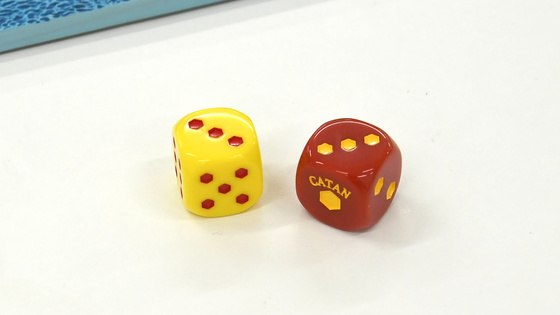
Then, the corresponding resource will be generated from the '6' tile on the board. In the example below, there is a 6 token in the field in the lower right. This field is adjacent to a yellow settlement, so the yellow player can get one wheat resource card. 6 is one of the most common dice rolls, so the yellow player can get a relatively large amount of wheat.
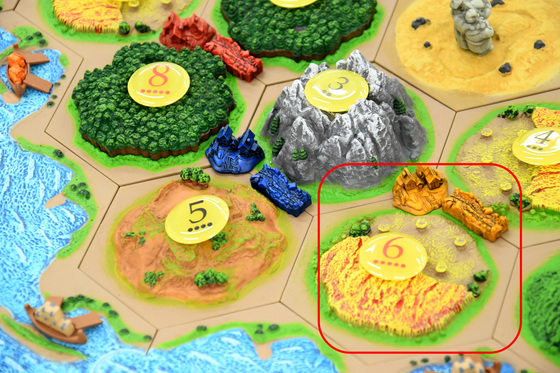
However, if the dice show a 7...
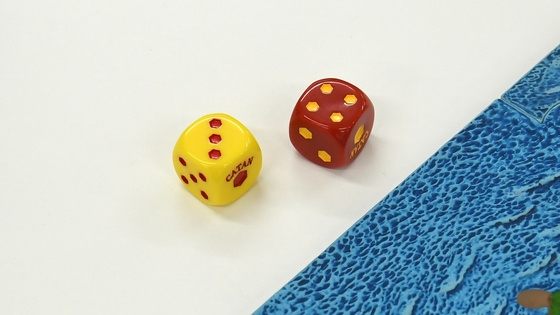
The bandit in the central desert starts to move. The player who rolled a 7 can move the bandit to any position. The location of the bandit cannot produce resources even if the dice show a number. Also, players with 8 or more cards must discard half of them, so the bandit can disrupt the flow of the game in an instant.
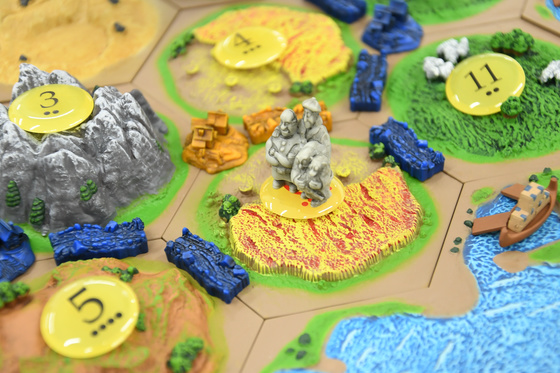
In addition, the player who rolled a 7 can randomly steal one card from one of the players whose settlement or city is adjacent to the tile where the bandit was placed. The yellow player who was the victim of the bandit this time not only had his wheat resource tile nullified, but also had his precious resource taken from his hand, so it was a double blow.
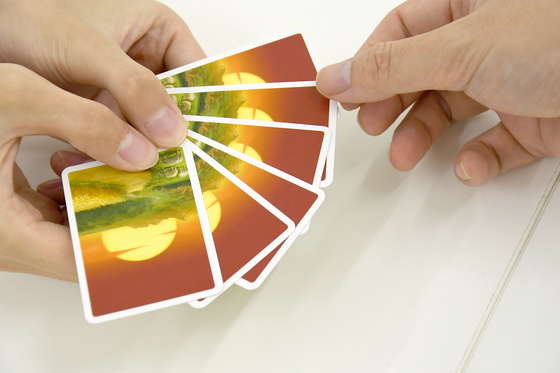
So the yellow player, who was building a settlement in the wheat port, used the two remaining wheat materials...
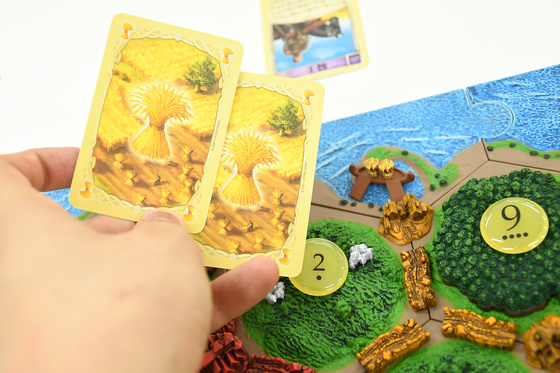
Exchange for sheep. The key to Catan is to be able to negotiate with other players to exchange resources that you are lacking, but this time no one will come to the negotiating table, so you have to do it yourself. The yellow player, who can easily get wheat, thought that 'if I get a wheat-exclusive port, I'll be able to do something,' but when the wheat is stopped by bandits, he is helpless.
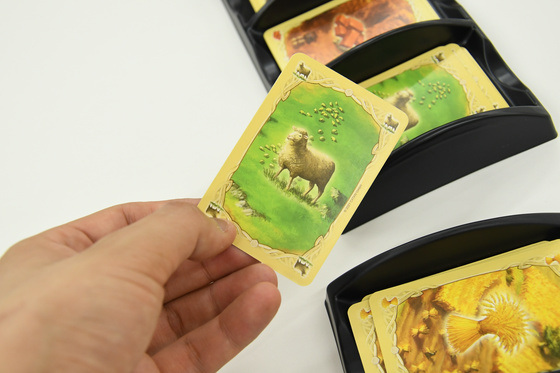
By paying one sheep, one iron, and one wheat...

You can draw one development card.
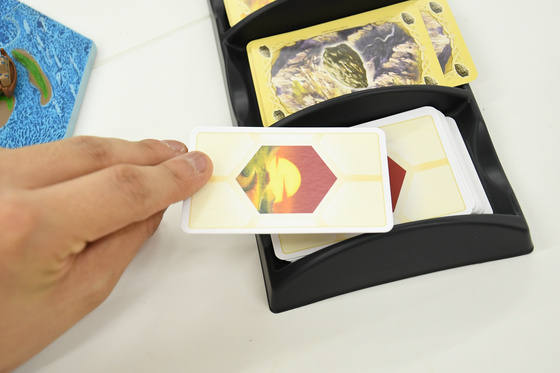
The next card he draws is a 'Knight' card. This Knight card allows the player to move the thief. This somehow frees the yellow player from the wheat shortage.
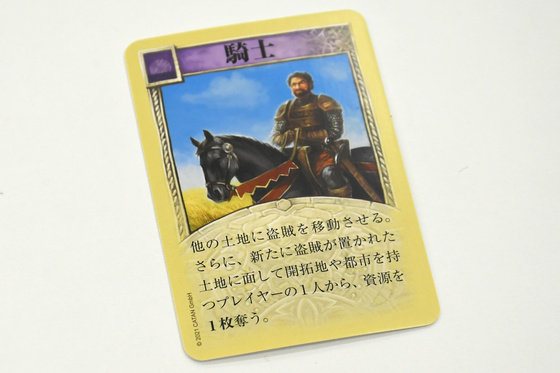
The effect of the knight is to move the thief to another location. The thief can be very troublesome when he appears, but by using the knight card you can intentionally hinder your opponent, so depending on how you use it, he can be a powerful ally.
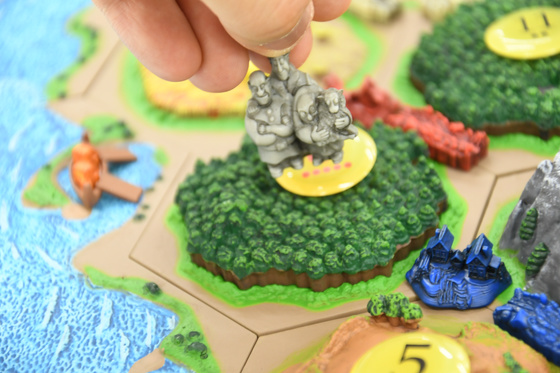
In the following scene, the blue player has installed one highway by paying one each of 'earth' and 'wood' resources.
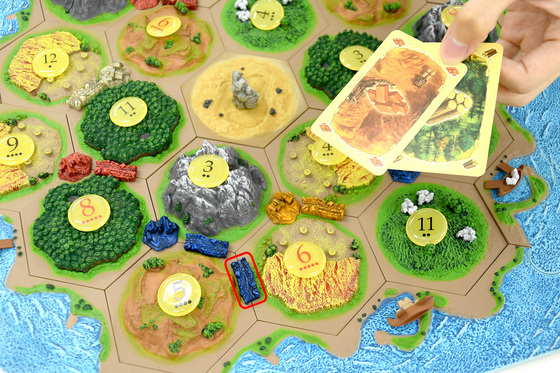
In order to get resources, you need to build settlements, and you can only build settlements where your roads are connected. Therefore, in Catan, it is very important to think about how to extend your roads. In the following scene, the red player is vigorously extending his roads. Up to six roads are connected.

Since the length of my roads exceeded five, I got the 'Longest Trade Route' card.

In addition, pay two wheat and three iron ...

Upgrade one of your settlements into a city. When you upgrade a settlement into a city, you receive 2 victory points for each settlement and double the amount of resources it receives.
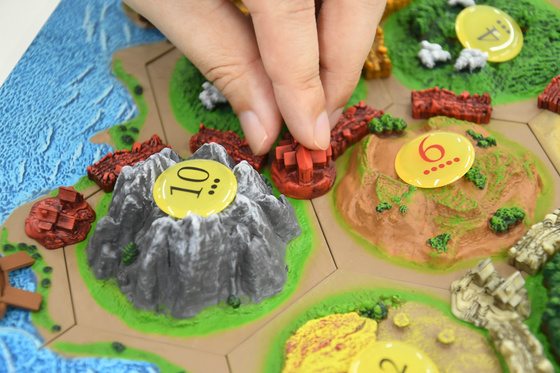
The other players are in a hurry when they see that the red player has suddenly increased his points. The white player pays three wood and three earth ...

Constructed three new roads at once, increasing the number of roads to seven.
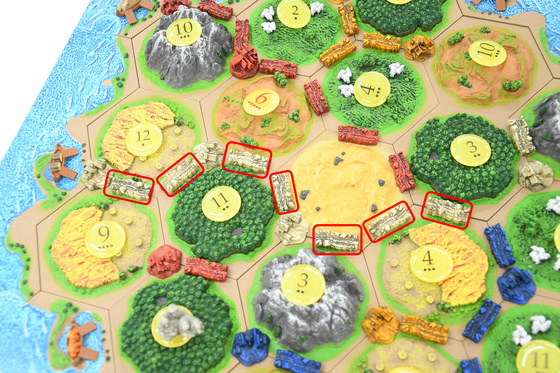
The 'Longest Trade Route' card goes to the player who has the longest road. This time, the white player has connected the road longer than the red player, so he succeeded in stealing the 'Longest Trade Route' card, which is worth 2 victory points.
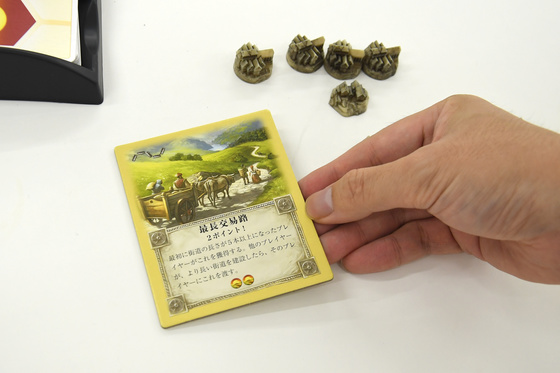
However, at this point, the red player has built three settlements and two cities, which means that he has earned 1 point x 3 + 2 points x 2 = 7 points.

So the red player decided to draw two development cards at once.

Some development cards directly lead to victory points. By drawing two development cards at once, the player gained three victory points, including the one development card he had originally, bringing his total to 10. The game ended with the red player winning.
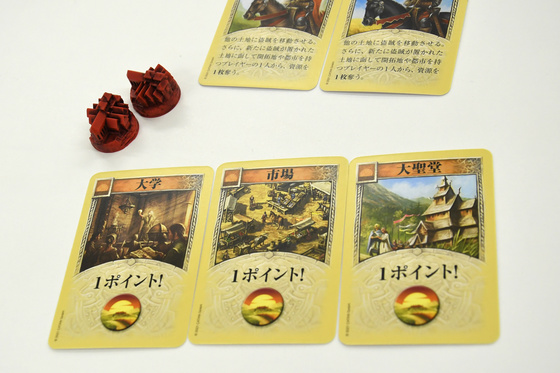
The rules of the 3D version of Catan are exactly the same as those of the regular Catan, but the game uses gorgeously three-dimensional terrain tiles and pieces, so the tension rises to a great extent. An editorial staff member who has played Catan in the past commented, 'The road pieces are really designed like roads, so I was excited when I connected them,' and 'The miniatures are well made, so my imagination is stimulated when building more than in regular Catan.' On the other hand, some comments said that the settlement and city pieces are difficult to distinguish at a glance, and that the three-dimensional nature of the pieces makes it difficult to see the roads and settlements when sitting down, so there are some parts where visibility is inevitably reduced. When playing, it is better to stand up from your chair and play so that you can see the board clearly from above, rather than playing while sitting down.
The Catan 3D version will be released in limited quantities on September 17, 2021. The manufacturer's suggested retail price is 47,000 yen including tax. In addition, there is a campaign on Twitter where one person can get Catan 3D for a limited time until August 31, 2021, so if you are interested, please check it out.
[ #Summer Holiday Special Event ] #Catan 3D Release Commemoration Campaign
— GP Public Relations, Inc. (@gpinc_jp) August 11, 2021
This is a limited production item that has already sold out.
We have prepared one special item for this summer!
The list price is 40,000 yen, we can't sell such an expensive item anymore!
Please join us!
<How to apply: Follow & Retweet> #Catan #Boardgame #Boardgame #OnlyCatan can winpic.twitter.com/Nf5HgeN8Ui
Related Posts:







